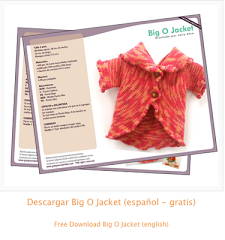
Circular needles are a long strand of nylon cord with two short needles attached at either end. You can use circular needles to flat knitting (knitting back and forth, projects such as jackets and afghans) and for knitting in the round ( joining the ends and knitting around and around, projects such as hats and sweaters).
Circular needles have two major benefits. First, by knitting in the round you can produce seamless garments. Second by flat knitting you can knit large projects such as afghans.
In both techniques, the major plus for circular needles is that the bulk of the weight of your garment sits on the nylon cable, which usually rests comfortably on your lap. The needles will carry only a portion of your working stitches, this putting significantly less stress on your hands and wrists.
Circular needles come in all sizes and many lengths, which is measured from tip to tip, ranges from 12 inches (30 cm) up to 60 inches (150 cm). The length you choose will depend upon the number of stitches to be worked. The longer ones are suitable for large garments and the shorter ones are ideal for small projects. They can be purchased with metal, bamboo, wood, acrylic or plastic. You can also purchase interchangeable circulars that give you a more flexibility in the use of the needles for projects.
. Flat Knitting on Circular Needles:
Anything that can be knitted on two straight needles can be knitted back and forth on circulars just as easily and with less shoulder and wrist strain.
When you use circular needles for flat knitting, you don't join the round. just cast on and knit. Knit from the left needle to the right as usual, and when you get to the end of the row, switch hands just like you would in knitting with straight needles.
Many also prefer to use circular needles for flat knitting as well because of the weight of the knitting slides around the nylon cable.
. Knitting in the Round on Circular Needles
Also Known as Circular Knitting and Tubular Knitting. Knitting in the round on circular needles allows you to create tubular knitting. Circular knitting is knitted in rounds, working around and around without turning the work. In circular knitting the right side is always facing you. So, if you knit every row, you will create a stockinette stitch. To create a garter stitch, you will alternate one knit row with one purl row.
How to Knit in the Round:
1. Casting On:
Cast on the required number of stitches on to one of the needle ends, just as you would for straight knitting, and distribute the stitches evening around the circular needle, careful not to twist the stitches. (Use the method of your choise, my favorite cast on method on circular needles is the Long Tail Cast on)
After casting onto circular needles and preparation for joining, arrange the stitches so that they are not twisted.
2. Holding needles:
Hold the end of the needle that the working yarn is attached to in your right hand. Place a stitch marker on your right needle. This marker will indicate the end of the round.
3. Knitting the first stitch to join the round:
Before you make your join, make sure that the stitches are not twisted around the needle and all the stitches are facing the same direction. That means all the little loopy bits from casting on the stitches should be on the inside of the circle made by the circular needle. Always keep the cast-on edge facing the center.
First, place a stitch marker between the first and last cast-on stitches and then join.
To join, hold the tip of the needle in the last cast-on stitch with your right hand and the tip of the first cast-on stitch with your left hand. Knit the first stitch and gently pull the yarn tight to avoid a gap.
: Use the needle in your right hand and knit the first -cast-on- stitch from the needle in your left hand, pull up the yarn (on this first stitch only) so that the join is snug.
4. Continue working the stitches:
Knit all the way around until you come to the stitch marker (you will find that you need to periodically redistribute the stitches evenly around the circular needle so that they do not pull.), and one round has been completed. Slip the marker from the left needle to the right needle and continue working the number of rounds required. You will slip the marker to the right-hand needle before each round.
Is very easy but you need to know a few tips to insure a well knitted garment.
- If you find that your circular needles curl when knitting, before using them again, immerse them in hot water for a few minutes to straighten them out. This will help the needle uncoil.
- When you knit a hat, there is a point at which your knitted tube will be too small to be worked on circular needles. At that point, you will need to do your circular work on Double Pointed Needles.
- Another characteristic of knitting in the round is that the right side is always facing you. That means you’ll need to alter your basic pattern stitches to get them to come out right.
- Circular knitting in stockinette stitch is great because all you have to do is knit every row. To make garter stitch, instead of knitting every row you’ll need to knit one row, purl one row. For reverse stockinette, you purl every row.
- Patterns that are designed to be knit in the round usually will be written so you don’t have to think about the fact that you’re always on the right side.
Knitting on Circular Needles
Video:
Publicado por Tejer Bien ![]()
Etiquetas: circular needles
Suscribirse a: Enviar comentarios (Atom)



0 comentarios:
Publicar un comentario en la entrada